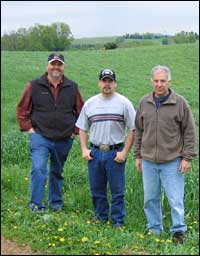Calls Grow to Subsidize Green Farming
 by Dan Charles
by Dan Charles

Dan Charles, NPR
Art Thicke (right) says the current farm subsidy system encourages farmers to grow crops that damage the environment. Also pictured: Tex Hawkins (left), of the U.S. Fish and Wildlife Service, and Chad Crowley (center), who works on Thicke's farm.
Farm Subsidies: Key Facts
Under the current federal farm-subsidy system, cotton and rice farmers can get up to hundreds of dollars per acre in production subsidies. These farmers would be unlikely to get as much money if the U.S. switched to a system that subsidized them for improving the environment instead.
-- The federal government expects to pay farmers just over $24 billion in 2005, a new record.
-- The subsidies are distributed through a variety of programs. Some payments kick in when crops fail, or when prices for key commodities, such as corn, fall below a target level. Others are based solely on how much a farm produced in the past.
-- Five crops -- corn, wheat, cotton, soybeans and rice -- account for two-thirds of all subsidies. Vegetable growers and ranchers get very little government money.
-- Large commercial farms, which account for 9 percent of all farms, get more than half of all subsidies.
Farm Subsidy Distribution
Source: USDA The chart above looks at direct government payments to farmers. Agricultural areas that rely heavily on subsidies include:
• the Corn Belt, where corn and soybeans dominate
• the southeastern Coastal Plain, source of cotton and peanuts
• the lower Mississippi River, where cotton and rice are grown
• west Texas and southern Arizona, where cotton is important
• California, where rice and cotton are important
More from Dan Charles
Morning Edition, July 11, 2005 · The federal government is expected to pay $24 billion in farm subsidies this year. Critics, including quite a few farmers, say taxpayers shouldn't pay for corn or cotton surpluses. Instead, they say the funds should go toward things that benefit the public, such as cleaner water and a healthier environment. Dan Charles has the first of two reports for
Morning Edition.
Web Extra: For NPR.org, Dan Charles takes a closer look at a new U.S. government initiative that pays farmers to help the environment:
Art Thicke jokes that he might dig a ditch through the hill that's next to his farm, because if water draining from his land could somehow get through that hill, he might qualify for a check from the federal government.
That hill separates Thicke's farm, near the town of La Crescent, in southeastern Minnesota, from the boundaries of the Root River watershed. (Rain that falls within that area drains into the Root River, which in turn runs into the Mississippi.) The watershed is one of 220 areas around the country where farmers can apply for funding this year from the U.S. Department of Agriculture's Conservation Security Program (CSP).
The CSP is a new initiative. It pays farmers to give the environment a helping hand. Farmers can qualify for payments if they can show that they've done a good job protecting the environment in the past. They must also show that they're preventing manure or other fertilizer from running into streams, and that they're conserving soil and minimizing pesticide use.
Once they qualify, farmers can get extra points -- and higher payments -- for doing additional things that provide habitat for wildlife or protect streams and groundwater. They include cutting back on fertilizer or pesticides, converting crop land into permanent pasture, or building windmills to supply the farm with energy.
Art Thicke's farm probably would qualify for a good-sized payment. Environmental experts consider his farm a model for other farmers. Twenty years ago, Thicke stopped growing corn and soybeans and converted those fields into pastures for his cows instead. That stopped soil erosion, and his pastures have become a haven for ground-nesting birds like bobolinks and meadowlarks.
Congress established the CSP in 2002, but it's just now getting off the ground. It will distribute about $240 million to farmers this year.
That's just 1 percent of all federal farm subsidies. Art Thicke -- along with other environmentalists and farm activists -- wishes it were a lot more. "I'd like to see a farm program that was all based on conservation," he says.
And even though Art Thicke won't get any of that money this year, he should get another chance in the future. The program expects to include a new batch of watersheds each year. USDA officials say that within eight years, it will reach every watershed in the country. -- Dan Charles
http://www.npr.org/templates/story/story.php?storyId=4735566




